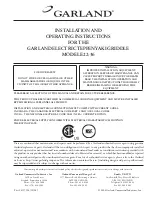
Part #GCGTRAINING06 (03/03/08))
Page 1
SERVICE BULLETIN #95-5
FROM
– National Service Department
BULLETIN NO . #95-5
TO
– National Service Binder Holders
DATE – February , 1995
Subject:
Subject: Thermocouples used in the Chain Griddle
Models CG-36, CG-48, CG-60 & CG-72
This bulletin supplements the chain Griddle Service Manual with a description of the basics of
thermocouple theory and how to use the degree/millivolt tables issued as part of this bulletin .
This bulletin deals with the thermocouple only and how it registers temperature changes .
The type J thermocouple on the new Chain Griddle measures the plate temperature within a
range of accuracy of ˚F to ˚F . The J designation refers to the conductors used and, therefore, the
thermoelectric characteristics of the conductors that form the thermocouple . In the Type J unit,
the conductors are iron and the alloy constantan . Constantan is an alloy of copper and nickel .
Thermocouple technology for sensing temperature has been in use for a long time but the Type J
thermocouple is new to Garland Commercial Ranges Limited applications .
To dissimilar metals joined together, as in Figure 1, cause a thermoelectric current to flow in the
circuit formed when the junctions are at different temperatures . The current will continue to
flow as along as the junctions (T1 and T) remain at different temperatures . Thermoelectricity
is the direct conversion of heat into electricity and vice versa . The electric motive force (emf)
producing the current is called the “Seebeck Thermal Emf” (Seebeck after the discoverer), and is
proportional to the temperature difference between the two junctions .
Three laws govern the way thermocouples work: the law of homogeneous circuits, the law of
intermediate metals and the law of successive or intermediate temperatures . The first law is that
a thermocouple circuit must use different metals; the second is that a third metal introduced
will not affect the couple provided it is maintained at the same temperature along its entire
length; the third provides a means of relating the emf generated to a standardized constant
temperature . Refer to a textbook about thermocouples for a fuller explanation of these laws .
Metal A
T
1 junction
T
2 junction
T = Temperature
I = Current
V = Voltage (emf)
Metal B
Metal B
Figure 1
V
I
If the cold junction is at a known or reference temperature it is a simple matter to compare this
with the hot junction at the probe of the thermocouple to obtain an accurate measure of the
hot junction temperature . In practice, the cold junction is eliminated by the use of electrical or
hardware compensating methods .
Summary of Contents for CG-24
Page 18: ...Part GCGTRAINING06 03 03 08 Page 18...
Page 19: ...Part GCGTRAINING06 03 03 08 Page 19...
Page 20: ......


































